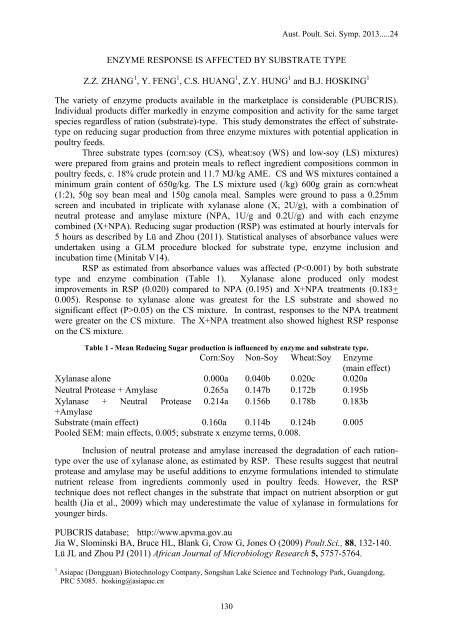APSS 2013 Proceedings - The University of Sydney
APSS 2013 Proceedings - The University of Sydney
APSS 2013 Proceedings - The University of Sydney
Create successful ePaper yourself
Turn your PDF publications into a flip-book with our unique Google optimized e-Paper software.
Aust. Poult. Sci. Symp. <strong>2013</strong>.....24<br />
ENZYME RESPONSE IS AFFECTED BY SUBSTRATE TYPE<br />
Z.Z. ZHANG 1 , Y. FENG 1 , C.S. HUANG 1 , Z.Y. HUNG 1 and B.J. HOSKING 1<br />
<strong>The</strong> variety <strong>of</strong> enzyme products available in the marketplace is considerable (PUBCRIS).<br />
Individual products differ markedly in enzyme composition and activity for the same target<br />
species regardless <strong>of</strong> ration (substrate)-type. This study demonstrates the effect <strong>of</strong> substratetype<br />
on reducing sugar production from three enzyme mixtures with potential application in<br />
poultry feeds.<br />
Three substrate types (corn:soy (CS), wheat:soy (WS) and low-soy (LS) mixtures)<br />
were prepared from grains and protein meals to reflect ingredient compositions common in<br />
poultry feeds, c. 18% crude protein and 11.7 MJ/kg AME. CS and WS mixtures contained a<br />
minimum grain content <strong>of</strong> 650g/kg. <strong>The</strong> LS mixture used (/kg) 600g grain as corn:wheat<br />
(1:2), 50g soy bean meal and 150g canola meal. Samples were ground to pass a 0.25mm<br />
screen and incubated in triplicate with xylanase alone (X, 2U/g), with a combination <strong>of</strong><br />
neutral protease and amylase mixture (NPA, 1U/g and 0.2U/g) and with each enzyme<br />
combined (X+NPA). Reducing sugar production (RSP) was estimated at hourly intervals for<br />
5 hours as described by Lü and Zhou (2011). Statistical analyses <strong>of</strong> absorbance values were<br />
undertaken using a GLM procedure blocked for substrate type, enzyme inclusion and<br />
incubation time (Minitab V14).<br />
RSP as estimated from absorbance values was affected (P0.05) on the CS mixture. In contrast, responses to the NPA treatment<br />
were greater on the CS mixture. <strong>The</strong> X+NPA treatment also showed highest RSP response<br />
on the CS mixture.<br />
Table 1 - Mean Reducing Sugar production is influenced by enzyme and substrate type.<br />
Corn:Soy Non-Soy Wheat:Soy Enzyme<br />
(main effect)<br />
Xylanase alone 0.000a 0.040b 0.020c 0.020a<br />
Neutral Protease + Amylase 0.265a 0.147b 0.172b 0.195b<br />
Xylanase + Neutral Protease 0.214a 0.156b 0.178b 0.183b<br />
+Amylase<br />
Substrate (main effect) 0.160a 0.114b 0.124b 0.005<br />
Pooled SEM: main effects, 0.005; substrate x enzyme terms, 0.008.<br />
Inclusion <strong>of</strong> neutral protease and amylase increased the degradation <strong>of</strong> each rationtype<br />
over the use <strong>of</strong> xylanase alone, as estimated by RSP. <strong>The</strong>se results suggest that neutral<br />
protease and amylase may be useful additions to enzyme formulations intended to stimulate<br />
nutrient release from ingredients commonly used in poultry feeds. However, the RSP<br />
technique does not reflect changes in the substrate that impact on nutrient absorption or gut<br />
health (Jia et al., 2009) which may underestimate the value <strong>of</strong> xylanase in formulations for<br />
younger birds.<br />
PUBCRIS database; http://www.apvma.gov.au<br />
Jia W, Slominski BA, Bruce HL, Blank G, Crow G, Jones O (2009) Poult.Sci., 88, 132-140.<br />
Lü JL and Zhou PJ (2011) African Journal <strong>of</strong> Microbiology Research 5, 5757-5764.<br />
1 Asiapac (Dongguan) Biotechnology Company, Songshan Lake Science and Technology Park, Guangdong,<br />
PRC 53085. hosking@asiapac.cn<br />
130
















